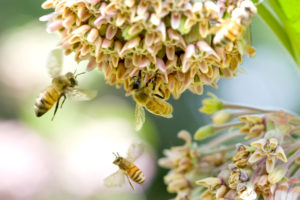
Pollinator declines continue at alarming rates. These dramatic losses coincide with a major shortage among Minnesota’s 400+ species of native bees.
With many Minnesota counties already lacking sufficient native pollinators to support the crops in those areas, we can’t afford for this problem to get worse.
Pollinator declines are influenced by multiple, interacting factors: increased pesticide use, habitat loss, disease and parasite pressure – and climate change. In particular, a 2016 Minnesota Department of Agriculture review identified the strong body of research linking neonicotinoid pesticides (“neonics”) and other systemic pesticides with pollinator declines. The scientific evidence has only grown stronger since.
The Goal: Help our pollinators make a comeback in Minnesota.
How to Get There:
- Offer farmers an incentive to switch from planting neonic-treated corn and soy seed to non-treated seeds. Many farmers are interested in transitioning away from seeds coated with neonics (they can be more expensive, and research shows that they aren’t really helping farmers anyway), but there are logistical barriers to moving away from what has become standard practice for so many.This program would be modeled after a new federal USDA Conservation Stewardship Program Enhancement that provides corn and soybean farmers with financial assistance to plant seed without neonic treatments.
- Help homeowners and retailers pick the right product by making neonicotinoid insecticides available only to licensed applicators (like farmers.) Currently, many pesticide products containing neonics are available to the general public – homeowners, nursery growers and landscaping organizations are able to use them without becoming a licensed applicator. While these kinds of consumer uses do not make up a large percentage of overall neonic use, when the average individual in these groups uses neonics, they tend to greatly over apply the chemical — up to 120 times the amount approved for agriculture.
- Restricting use and sale of neonics to only certified applicators would significantly limit this unnecessary exposure for pollinators — while also:
- protecting urban waterways from neonic contamination
- protecting the habitat of the Rusty Patched Bumble Bee, which largely covers the Metro area of Minneapolis- St. Paul.
Other states have already passed this type of legislation. This is a great opportunity for Minnesota to lead in the Midwest.
- Assist homeowners who want to make their lawns into pollinator-friendly habitat. Increased pollinator habitat helps everyone across the state. Investing state resources to launch a cost-share program would help give homeowners an incentive to move from the resource intensive grassy turfs to plants that help our pollinators, clean our water, and sequester carbon.
- Create a Pollinator Protection Account. We know enough about what pollinators need to thrive to know that it will take work, resources and resolve. Nothing will be a one-time fix. Minnesota needs a way to ameliorate the harm done by pesticides to the pollinators themselves and their habitats. We can fund this work through fees on pesticide treated seeds and the pesticides classified by the USEPA as moderately or highly toxic to pollinators on acute exposure basis.
- Authorize a Pesticide Treated Seed Program. Give the state clear authority to:
- Regulate treated seeds (like they have for all other pesticides)
- Track the use of pesticide treated seeds
- Fund research on the efficacy of seed treatments
Without this authority clearly stated, we risk state agencies not gathering the information we need to protect public health and help farmers make the best decision about what is cost-effective for their operations.
Follow us on social media or subscribe to our Environmental Insider email to keep up with the latest.